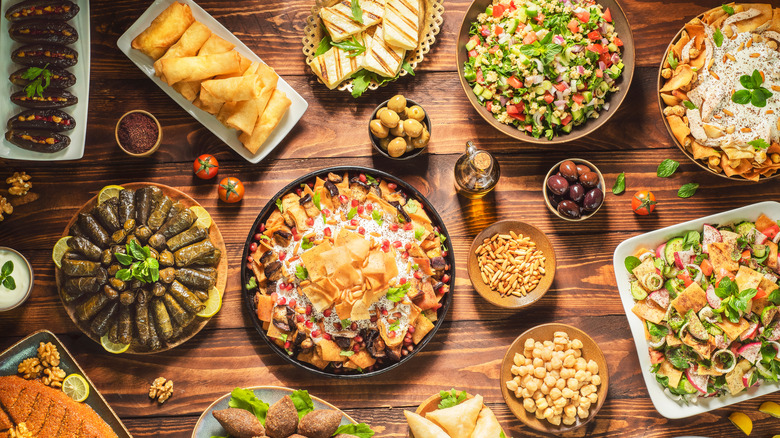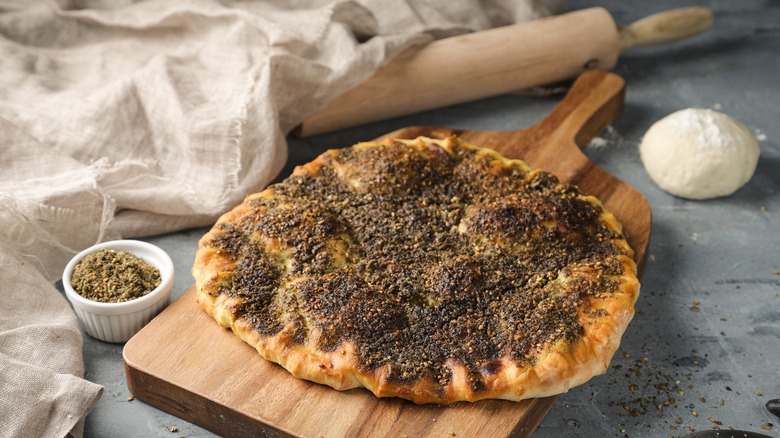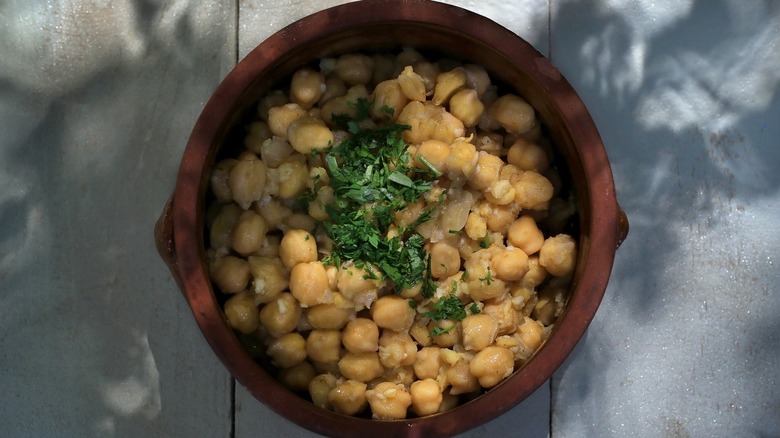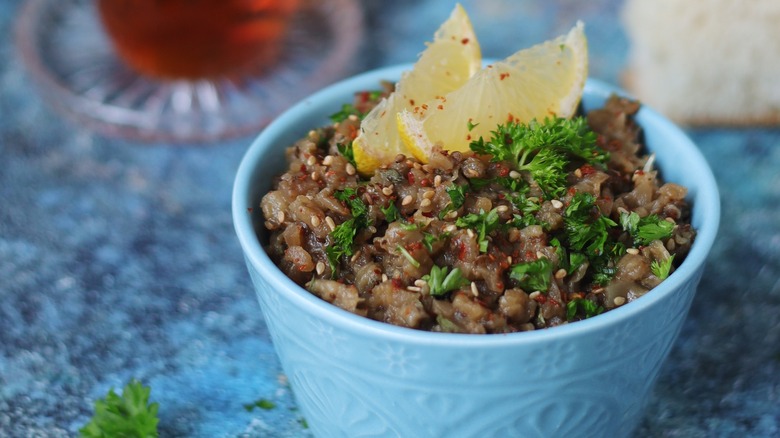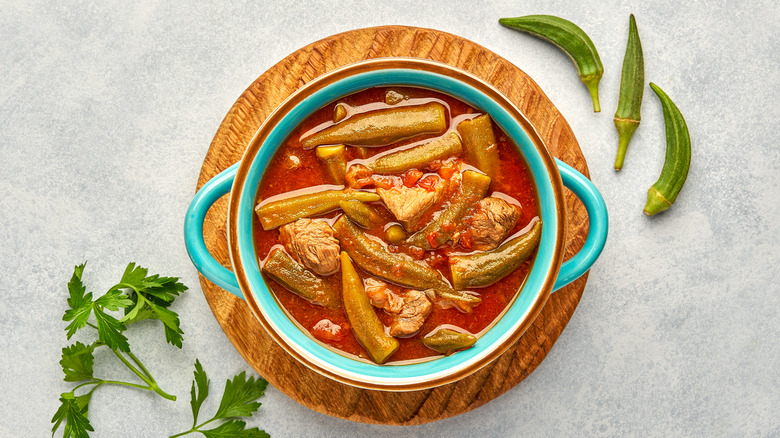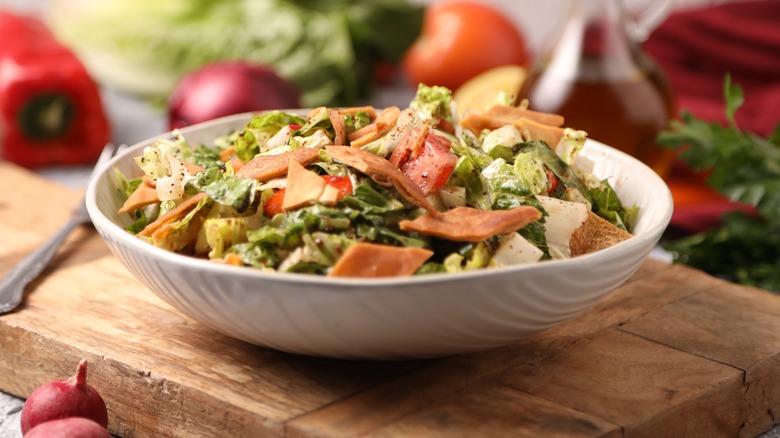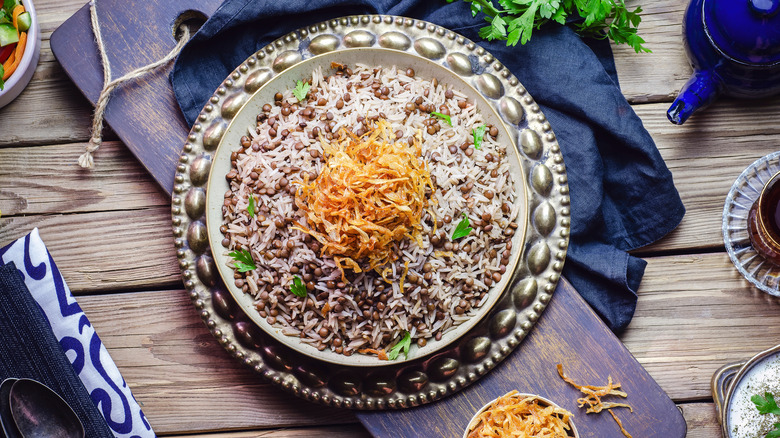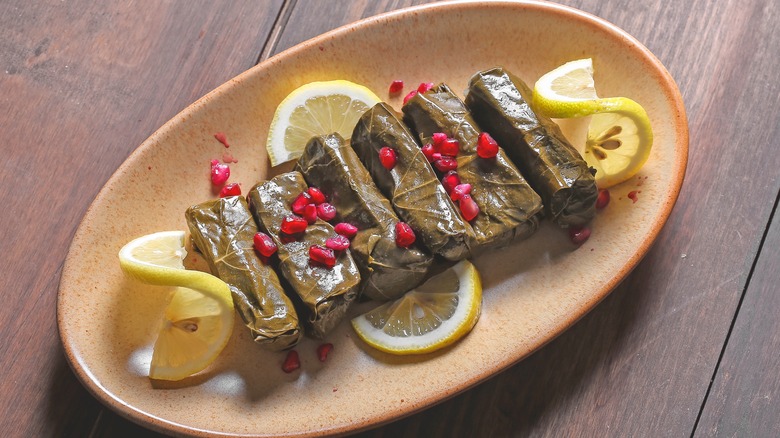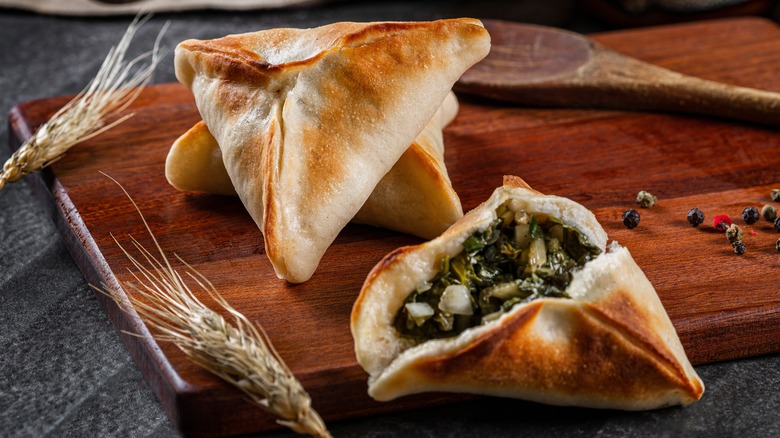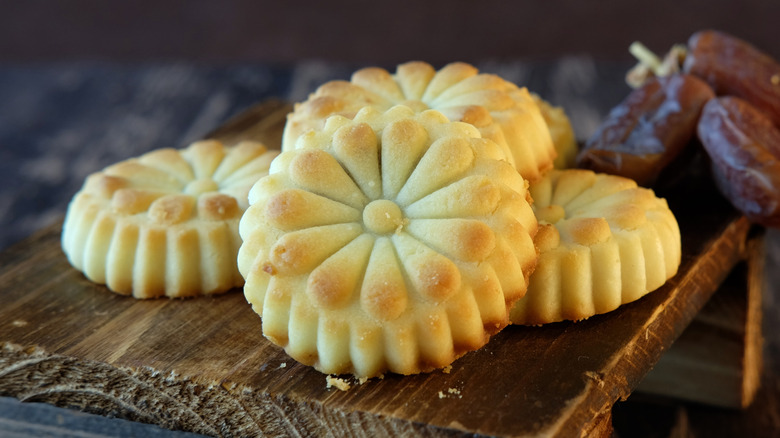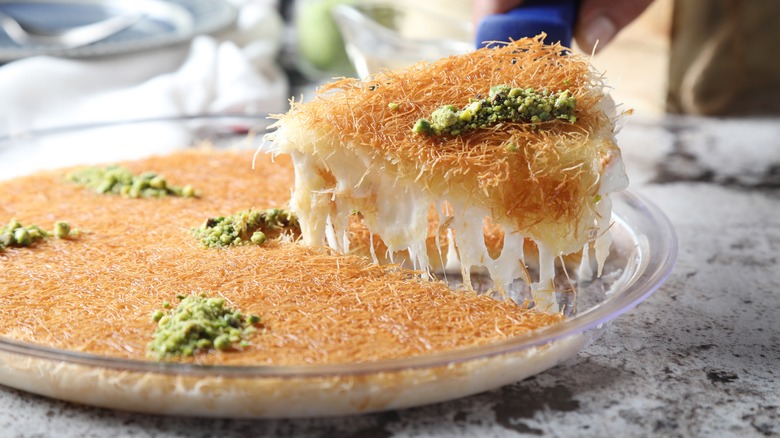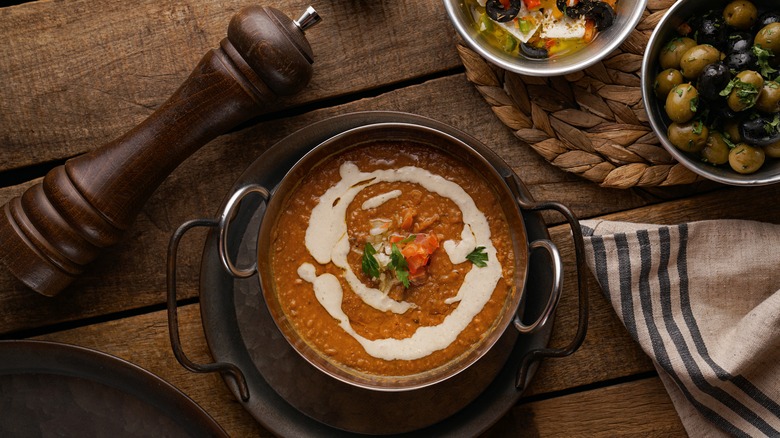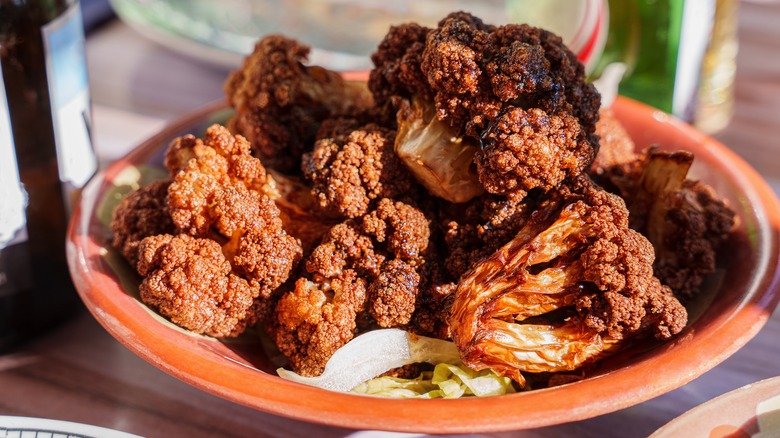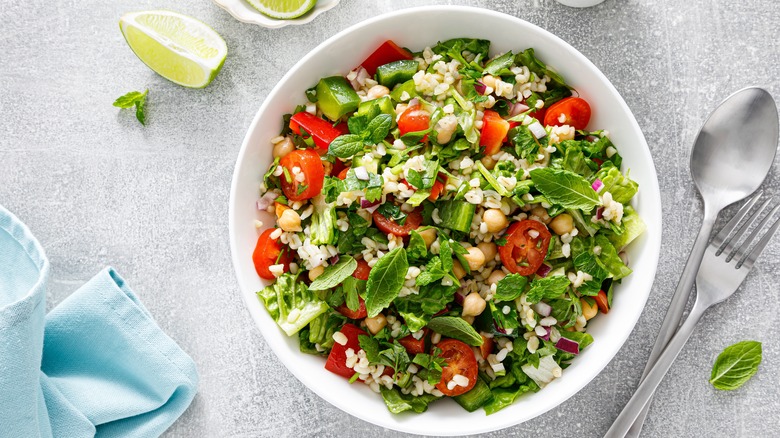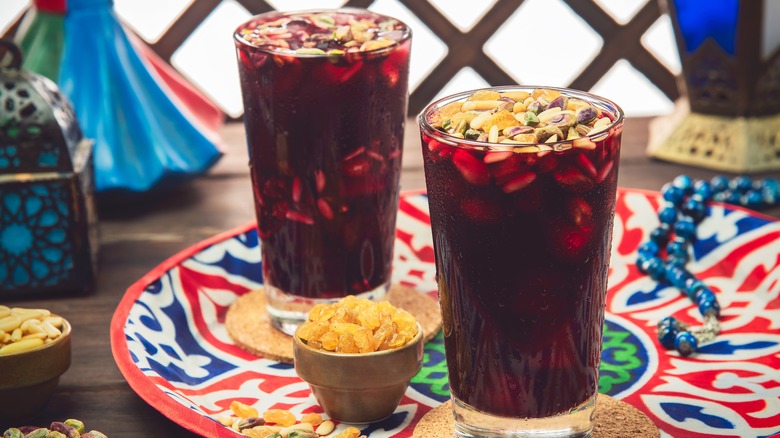14 Lebanese Foods You Need To Try Before You Die
Lebanon has a rich culinary history that many people only know the half of. Sure, you've probably tried falafel and shawarma, but the amazing foods this region has to offer extend far beyond that. We want to shed some light on more of the delicacies Lebanon has to offer — and that you should try.
One thing that's interesting about Lebanese cuisine is that it has a lot in common with other Middle Eastern food. This is likely due to the impact of the Ottoman Empire, which spanned much of the Middle East and ruled Lebanon from the early 16th century to the early 20th century. However, this doesn't mean there isn't a distinct Lebanese food tradition. Some dishes are unique to Lebanon, while others are found all over the Middle East in some form, but have a Lebanese twist.
These are the 14 Lebanese foods you need to try before you die. From delicious topped flatbreads like manakeesh to bright, fresh stuffed grape leaves called warak enab, there's a huge range of dishes to try. You might just find your new favorite food.
1. Manakeesh
Also known as man'oushe, manaquish, al-man'ouché, or several other spelling variations, manakeesh is a traditional Lebanese flatbread. While it's popular across the Levantine region, it's especially common and significant in Lebanon, where UNESCO has even granted it status as an emblematic culinary practice.
But, what's special about this flatbread? Well, it has a puffy, airy yeasted base, more akin to a pizza base than to an unleavened flatbread, such as a tortilla. It has a number of traditional topping options, including a blend of Lebanese cheeses and a mixture of onions and tomatoes. However, our favorite way to enjoy it is slathered in za'atar and olive oil. For those not in the know, za'atar is a blend of dried thyme, oregano, marjoram, sumac, and toasted sesame seeds.
In Lebanon, it's considered a default breakfast food. You can buy it from street food vendors all over towns and cities. If you don't want to travel to try manakeesh, you can find it in some Lebanese restaurants and Middle Eastern bakeries in the U.S. While it might not be a common breakfast in this part of the world, it's delicious enjoyed at any time of day.
2. Balila
A Lebanese chickpea dish, this form of balila isn't to be confused with Egyptian balila, which is a wheat porridge. Balila is the Arabic word for cooked or boiled chickpeas and this dish consists of chickpeas with lemon juice, garlic, herbs, and spices.
The chickpeas are simmered until they're extremely soft and tender, with the aromatic ingredients added at various points in the cooking process. The chickpeas are then mashed to form a thick, chunky paste, with some chickpeas left whole, some partially mashed, and some completely mashed into the liquid to thicken it. The resulting dish is often somewhere between a soup and a stew, although there are thicker, drier variations. It only contains simple ingredients, but they're perfectly balanced into something greater than the sum of its parts.
When it's time to eat, balila is often served with pita or other Lebanese flatbreads. Like manakeesh, it's a traditional breakfast food. However, you can certainly enjoy it at other times of day if it doesn't take your fancy for breakfast.
3. Baba ganoush
If you think you've already had Lebanese baba ganoush, you might be wrong. You're probably thinking about a smooth, creamy eggplant dip that has an earthiness to it from the inclusion of tahini. This dip is called baba ganoush in some parts of the Middle East. However, in Lebanon, Syria, Armenia, and some other surrounding areas, this dip is called moutabel, and baba ganoush is something slightly different.
Lebanese baba ganoush consists of smoky aubergine roughly chopped and mixed with other ingredients like onions, tomatoes, bell pepper, and pomegranate seeds. It's more like a salad than a dip. For traditional baba ganoush, the eggplant is cooked in coals or over an open flame, which gives it that smoky, charred flavor. Some versions of Lebanese and Levantine baba ganoush contain pomegranate molasses. This gives it a sweetness that balances out the rich smokiness of the dish.
It's usually served as part of a mezze spread, with other small plates and Lebanese bread. If you want to find it outside of Lebanon, you might need to try a few restaurants. Since most people in the U.S. think of baba ganoush as the creamy version, that's often what you find in Western Lebanese restaurants. However, if you see both moutabel and baba ganoush on the menu, you'll know that the moutabel is the pureed dip, while the baba ganoush is the sweet and chunky salad.
4. Yakhnet bamia
Bamia means okra in Arabic and the name of this dish — yakhnet bamia — translates to okra stew. That said, it's occasionally simply called bamia on menus and by people in the know. So, what can you expect from this Lebanese okra stew?
This is a simple one-pot recipe, consisting of okra, onions, tomatoes, and various herbs and spices. Like many stews, there are multiple variations of it, so just because you've had it once doesn't mean you know the ins and outs of it. For instance, it's often made using meat, but there are also plenty of vegetarian versions of it. You'll also find as many variations on the herbs and spices used as there are people regularly making this dish. However, you can expect some Middle Eastern classics, such as cilantro, parsley, coriander, and cinnamon.
You'll usually find this kind of stew served with rice, although nobody would be too upset if you wanted to eat it with flatbread. It's tasty, warming, and great for the winter months, whether you make it yourself at home or eat it at a restaurant.
5. Fattoush
There's one easy way to improve on any salad — and that's adding bread. Fattoush is a salad that's thought to have originated in Northern Lebanon, although it's also popular in other Levantine countries. It's known for its fresh, vibrant flavors.
The key ingredients typically include lettuce, a range of vegetables such as cucumbers, tomatoes, radishes, and green peppers, herbs such as fresh mint and parsley, and the star of the show: crispy pieces of toasted or fried pita bread. Other additions include a dressing that consists of olive oil, lemon juice, garlic, and sometimes vinegar and sumac — a tangy, lemony spice that is often used in Middle Eastern cuisine.
What's great about fattoush is that you can tailor it to what you have on hand or what's in season. You don't need to use the same veggies every time and can experiment with your dressing. Fattoush is a versatile salad that can be enjoyed on its own as a light meal or served alongside grilled meats or falafel. It's a perfect dish for showcasing the fresh flavors of seasonal vegetables.
6. Mujadara
Super simple, yet warming, comforting, and delicious, mujadara is a common dish in Lebanon, as well as in other parts of the Middle East. This straightforward dish is made with lentils, rice, and caramelized onions. It might not sound too exciting, but the combination of ingredients is delicious. It's one of those recipes that proves food doesn't have to be complicated to be amazingly tasty.
Let's look at this dish in a little more detail. We'll start with the lentils. Usually brown or green lentils are used. These hold their shape nicely, so they don't get lost in the rice. Speaking of the rice, most recipes use long-grain white rice, such as basmati. However, you can find some variations that use short-grain rice. Then, onions are a crucial component and are caramelized to provide sweetness and depth of flavor. Finally, spices are added to the mix for extra flavor. Common spices include cumin, coriander, and cinnamon.
To prepare mujadara, the lentils and rice are cooked together, and the onions are caramelized separately. The cooked lentils and rice are then mixed, and the caramelized onions are added on top. The dish is often served with yogurt or a side salad.
7. Warak enab
Warak enab, also known as grape leaves or stuffed grape leaves, is a popular dish in Middle Eastern cuisine. You might have heard of them as dolma in Greek or Turkish restaurants, but warak enab is the version enjoyed in Lebanon. The name warak enab is derived from Arabic, where warak means leaf and enab means grape.
The dish is made of large grape leaves that are stuffed with a mixture of rice, sometimes with the addition of ground meat, pine nuts, and various herbs and spices. The stuffed grape leaves are often rolled into small cylindrical shapes. Flavors can vary widely, depending on the choice of fillings and combinations of herbs, but they're usually fresh and vibrant.
You'll find warak enab on practically every Lebanese menu. It's a dish usually served with other mezze dishes. This is a great way to enjoy Lebanese food, as you can try a lot of different dishes at once.
8. Fatayer
Fatayer are a staple in Lebanese cuisine — and they're so tasty that you have to try them before you shuffle off this mortal coil. They're effectively individual hand pies, with a soft yeasted dough. You can find these kinds of savory pastries around much of the Middle East, but in Lebanon and other Levantine regions, they're known as fatayer.
Spinach is one of the most common fillings for fatayer. It's combined with onions and spices to make a tasty filling. However, there are a wide range of other filling options, including cheese, ground beef, and a mixture of za'atar and olive oil.
If you're interested in trying fatayer but don't want to make them yourself, you should be able to find them at most Lebanese restaurants. Generally, you'll find them as part of the mezze offerings, to enjoy with other small plates. They're also commonly available at Middle Eastern bakeries, should you have one in your city.
9. Ma'amoul
Now it's time to bring a little sweetness to this article in the form of ma'amoul. This is a traditional Lebanese cookie that is popular not only in Lebanon but also in various Middle Eastern countries. Ma'amoul cookies are typically made with a buttery semolina-based dough. The dough may contain a mixture of standard wheat flour and semolina flour and often uses clarified butter. In the center, these cookies can be stuffed with a variety of sweet fillings, such as dates, nuts (like walnuts, pistachios, or almonds), or figs. Additionally, they can be flavored with things like rosewater and orange blossom.
Ma'amoul cookies are often shaped using special wooden molds or hand-carved molds, resulting in intricate patterns on the surface. This makes them more than an everyday cookie. While they can be eaten all year round, they're often associated with special occasions and holidays. They're particularly popular at Eid, which marks the end of Ramadan, as well as at Easter for Middle Eastern Christians. Local bakeries and sweet shops in Lebanon may bake thousands of ma'amoul during this period.
10. Knafeh
Knafeh, also spelled kanafeh or kunafa, is a traditional Middle Eastern dessert that is popular in Lebanon, as well as various countries across the region. It is made with thin noodle-like pastry soaked in sweet syrup, and it is often layered with cheese or semolina and then baked to a golden brown color. Knafeh can be flavored with ingredients such as orange blossom or rose water, and it is commonly garnished with chopped nuts, such as pistachios or almonds.
Traditionally, it's made using a sweet cheese filling made with Middle Eastern cheese, such as ackawi or nabulsia. However, variations made in the U.S. can use ricotta or even mozzarella. The traditional dough used in this recipe is called kataifi, but it's effectively just shredded phyllo dough. The resulting dessert provides an array of flavors and textures like no other. Even if you're thinking that you're not sure about the combination, you're likely to be pleasantly surprised.
11. Ful medames
If you're wondering what the most popular Lebanese breakfast food is, ful medames (or foul medames, as it's also spelled) is in the running. This traditional Middle Eastern dish isn't exclusive to Lebanon, but it's commonly enjoyed there. This hearty dish, also known as ful or foul, is made with fava beans. It's often seasoned with olive oil, lemon juice, garlic, and various spices.
In Lebanon, ful medames is a popular breakfast or brunch dish, served warm or at room temperature. It's often eaten with flatbread, vegetables, and sometimes hard-boiled eggs. Some variations may include additional ingredients such as tomatoes, onions, or parsley. After the beans have been cooked with the other ingredients, some of them are mashed. This gives it a thick, creamy texture, rather than simply being a bowl of cooked, seasoned beans. How much is mashed and how much is left whole is up to the cook — and you'll find a range of variations. However, some people mash as much as 80% of the beans, giving it an almost dip-like consistency.
12. Arnabeet mekleh
The name arnabeet meklah literally translates to fried cauliflower, so you can guess what this popular Lebanese dish is all about. Individual florets are fried until they're golden brown and may even have some slightly blackened areas that only add to the flavor. However, it's worth noting that some home cooks may decide to roast the cauliflower instead of frying it. Of course, if you go to a restaurant to enjoy it, you can safely assume that it's fried and at its most delicious.
But, the dish doesn't end with the frying — it's also topped with a tahini sauce. The exact contents of these sauces can vary, but they're usually made by mixing tahini paste with water, lemon juice, and garlic, with salt added to taste. Like a lot of Lebanese dishes, this is often eaten as part of a mezze spread, so if you don't think cauliflower sounds that delicious on its own, think of it as one part of a large meal. However, we think it's among the tastiest Lebanese dishes around and yet more evidence that simple ingredients can be exceptionally delicious when cooked just right.
13. Tabbouleh
Tabbouleh is a popular Middle Eastern salad that originated in the Levant region, which includes Lebanon. Traditionally made with finely chopped parsley, tomatoes, mint, onion, and soaked bulgur (cracked wheat), it's fresh and vibrant. Generally, it's dressed with a mixture of olive oil and lemon juice and seasoned with salt and pepper.
Lebanon is thought to be the place of origin for tabbouleh, and it holds a special place in Lebanese cuisine. In fact, it's unofficially considered a kind of national dish. Tabbouleh is known for its fresh, zesty flavors, making it a popular choice during the hot summer months. The balance of herbs, vegetables, and grains, along with the citrusy dressing is complex yet well-balanced.
In Lebanon, tabbouleh is not only a side dish but can also be considered a main course. It is commonly served as part of a mezze spread. It's a staple in Lebanese households and has become a well-loved dish in many countries around the world. While you can find tabbouleh on many menus in the U.S. (not just in Middle Eastern restaurants), you'll never find it better than you can in Lebanon. Of course, if you're not making that long trip, tabbouleh from a good Lebanese restaurant comes a close second.
14. Jallab
Okay, this one isn't precisely a food, but rather a drink. Still, jallab is worth noting due to its popularity in Lebanon — and because it tastes amazing. It's a popular Middle Eastern beverage that is especially enjoyed during the holy month of Ramadan and other festive occasions. This sweet, refreshing drink is made from a mixture of ingredients, typically including grape molasses (also known as silan) and rose water.
To prepare jallab, the syrupy mixture is diluted with water and served over ice, sometimes with added pine nuts, raisins, or pistachios. Some variations may also include a splash of orange blossom water or a sprinkle of ground cinnamon for added flavor. Jallab has a rich, complex taste, combining the natural sweetness of the molasses with the floral notes of rose water. It is a beloved beverage across the Middle East and is enjoyed for its cooling properties, especially during warm weather or after a day of fasting during Ramadan.
